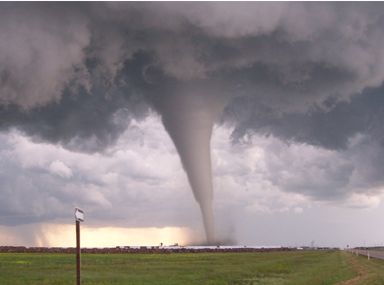 Home Security: Tornado Safety Home Security: Tornado Safety
No one likes to think about their home being destroyed by natural disasters. Unfortunately, there’s not much anyone can do to prevent tornadoes, hurricanes, or earthquakes from occurring. As homeowners, the best thing one can do is to be prepared in case one happens. This is especially important for people who live in areas of the country that see a high number of tornadoes each year, often nicknamed tornado alley. Even people who don’t live in this area should have a plan in case the unthinkable comes swirling towards their homes.
Preparation
A tornado is a rotation of wind that spins very fast and can cause an extreme amount of damage. A tornado can have wind speeds in excess of 300 mph which can level any man-made structure. Though scientists do not completely understand how a tornado, also sometimes called a twister or cyclone, forms, they do know that they most often occur when a low pressure system brings a supercell into a region where warm air sits near the surface. The warm air rising from the ground meets the cooler air higher up in the atmosphere, causing the air to circulate.
Knowing the warning signs of a possible tornado is very important, as weather reports are not always accurate and have an obvious time delay. A person can see a tornado and reach shelter long before a weatherman could even hear of the funnel. Ideally, people should take shelter when it looks like a tornado is imminent and not wait to see an actual funnel. Often the tornado cannot be seen because of heavy rain or low clouds. At times the funnel isn’t visible at all, only the debris flying around can be seen.
So what are the sings that a tornado is about to form or possibly has already formed? If a large wall of clouds has rolled in, that is a definite warning sign, as are clouds in the sky that are rotating, even if the rotation isn’t very fast. The speed could change in a heartbeat and a funnel could easily drop from clouds like this. If heavy rain is suddenly followed by a sudden calm or wind shift, take shelter immediately.
Sometimes a tornado can be heard far sooner than it can be seen since the accompanying storm often obscures visibility. A rumble that doesn’t go away could very well be a tornado. Other people describe the sound as a train approaching, especially if gets very close. Also if there are sparks of light near the ground, rather than lightening in the sky, this is probably power lines being snapped by the high winds.
To prepare for a possible tornado strike near your home, have a plan that the whole family knows and understands. Talk to children about what a tornado is and what the family will do if one comes close to the house. Practice tornado drills on a day with no weather activity so the kids know what will happen. Purchase a battery-operated radio and have plenty of batteries on hand so that information can still be received even if the power goes out.
Part of the tornado plan should be a safe room that everyone knows to go to during a tornado warning. This should be on the lowest level of the home. If the house has a basement or storm cellar, this is the best place to go, as being underground is the safest place to be. Keep this place stocked with water bottles, any necessary medicines, a first aid kit, or other needed items. If there is no basement or cellar, choose an interior room with no windows as the safe room. A bathroom, closet, or area under a staircase is best.
What To Do During a Tornado
If a tornado has been spotted or the weather radar has spotted one, take cover immediately. Tornadoes can form very quickly and be on top of a house with little to no warning time. If there is the least danger of a tornado have the family go to the safe room immediately. If possible take a cell phone and the pets into the room as well. Turn on the radio to a channel reporting the weather.
Clear the area of anything that could fall and injure the people in the room, like pictures on the wall or items on a shelf. An empty room is the safest, since this will reduce possible debris. Drag in mattresses, couch cushions, sleeping bags, anything that family members can cover up with to help protect their bodies from falling debris, which is the biggest danger in tornadoes. If the safe room is a bathroom, the bathtub can provide some protection, especially with a mattress thrown over the top.
Also teach family members how to take shelter if they are away from home. They can find the interior rooms on the lowest floor in the buildings they are in and curl up, protecting their head with their hands. Anyone caught in a car during a tornado should get out of the car at all costs. Preferably, find shelter in a structure. If there is no structure available, lie flat on the ground away from any cars and cover the back of the head with the hands. Don’t use bridges or overpasses as shelter, as these are actually more dangerous to be under than out in the open.
Anyone caught in a mobile home should also get out of the trailer immediately, even tied down ones. Studies have shown that people are safer in the open than in mobile homes. Again, find a solid structure or cellar if possible. If caught in a church or theater, if there are no interior rooms available or if there isn’t time to reach them, crouch under the pews or seats.
Because underground is the best place to be during a tornado, weather researchers, government officials, and emergency management organizations highly recommend that people who live in tornado alley or other areas with large amounts of tornadoes to invest in a safe room or storm cellar on their properties. FEMA even offers free building plans for such underground shelters as well as above ground safe rooms. Some businesses in these areas even sell prefabricated cellars. All the homeowner has to do is have the hole for it dug.
Aftermath
The freight train has left and all anyone can hear is an eerie silence. What should be done now that the tornado is over? The most important thing to do is to stay in the safe room until help arrives. If there is a cell phone available and it is still working, call 911.
Don’t leave the room yet, though. Tornadoes are unpredictable. Just because one has passed by doesn’t mean that it can’t make a u-turn or that another isn’t nearby. Even if the tornado missed the house, there could be dangerous debris all around. There could be broken glass in the house as debris or the change in air pressure can easily break windows. Most dangerously, there could be downed power lines which can kill.
If anyone needs medical help, attend to them and let emergency crews know there are injuries, as those will receive priority from first responders. Don’t go into damaged buildings, even to look for people, as these could fall with little provocation. Also natural gas could be leaking and there’s no way to see it. So don’t use anything that might cause a spark, like lighters, grills, or matches, as this could cause an explosion if there is a leak.
Finally, follow the directions of local officials. If a home is unlivable, the Red Cross and other organizations often set up temporary shelters. Once the family is safe, contact the carrier for the home owner’s insurance. Their representative will help get the home repair taken care of.
Other Tornado Safety Resources:
- Tornadoes – There are many warning signs that a tornado is imminent Knowing these sings can help save lives.
- Understanding Tornadoes – Understanding about how tornadoes form and behave can help home owners prepare for them.
- Tornado Guide - Learn about how tornado's are formed and the different shapes and forms it can take.
- Tornado Safety – Tornadoes are nothing to mess around with. Read about tornado safety for the whole family.
- Tornado Alley – Oklahoma City sits right in the heart of Tornado Alley. Read how this city prepares its residents for the all-too common threat.
- Safe Rooms – FEMA offers free building plans for underground shelters and above ground safe rooms.
- Tornado Safety – This site includes step-by-step instructions about that to do during a tornado and a printable checklist.
- Tornado FAQ – Have questions about tornadoes? This site answers them all.
Information For Kids
Other Natural Disaster Resources
- Natural Disasters – The Center for Disease Control offers a plethora of helpful information on different types of natural disasters.
- Hurricane Preparedness – Hurricanes can be just as devastating as tornadoes, and often over a larger area.
- Hurricanes – Learn more about the largest storms on the planet.
- Earthquakes – U.S. Geological Society has put together a comprehensive website about an often over-looked natural disaster.
- Earthquake Safety Checklist – The Red Cross has published a checklist to prepare people who live in earthquake-prone areas to prepare for them and be safe during them. (PDF)
- Tsunami – What is a tsunami? This site answers that question and many others.
- Tsunami Warning Center – The residents of California, Oregon, Washington, and Alaska are at the highest risk of destructive tsunamis. This warning center publishes data and issues warnings if the risk increases.
- Natural Hazards – NASA provides a birds-eye view of any natural disasters.
- Volcano Hazards Program – People who live near volcanoes need to be aware of the hazards this can involve. Know what to do in case of volcanic activity.
- Volcanoes – What can happen if a nearby volcano becomes active? What should people do during an eruption? This site answers volcano related questions.
- Disaster Assistance Programs – A natural disaster is bad enough if it takes a person’s home, but when it causes a farmer to also lose his crops or animals, it is particularly hard. The USDA has assistance programs set up for just such an emergency.
- Natural Disasters – This site has general information about traveling and natural disasters.
This article was written by Mike Haldas, co-founder and managing partner of CCTV Camera Pros. If you found it useful, please share it.
| Shop for video surveillance products |
|---|
| | | |
|---|
|









 Home Security: Tornado Safety
Home Security: Tornado Safety
